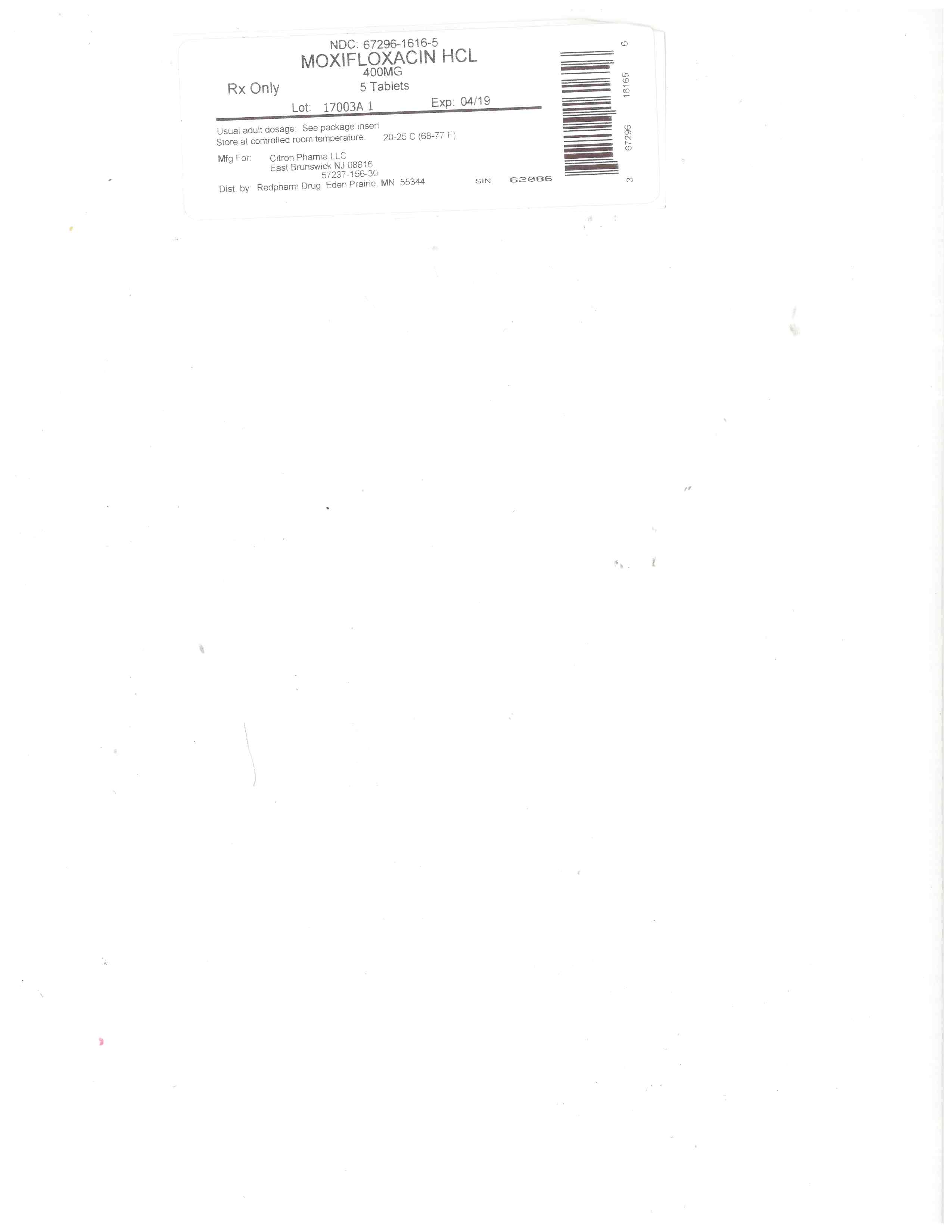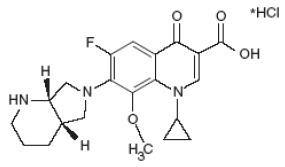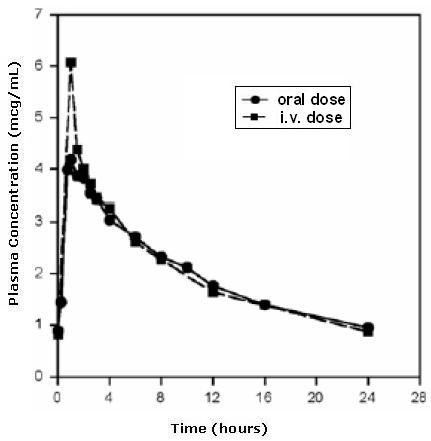Drug Catalog - Product Detail
MOXIFLOXACIN TAB 400MG 30CT
| NDC | Mfr | Size | Str | Form |
|---|---|---|---|---|
| 57237-0156-30 | RISING PHARMACEUTICALS | 30 | 400MG | TABLET |
PACKAGE FILES



Generic Name
Substance Name
Product Type
Route
Application Number
Description
11 DESCRIPTION Moxifloxacin hydrochloride is a synthetic antibacterial agent for oral administration. Moxifloxacin, a fluoroquinolone, is available as the monohydrochloride salt of 1-cyclopropyl-7-[(S,S)-2,8-diazabicyclo[4.3.0]non-8-yl]-6-fluoro-8-methoxy-1,4-dihydro-4-oxo-3 quinoline carboxylic acid. It is a slightly yellow to yellow powder or crystals, slightly hygroscopic substance with a molecular weight of 437.9. Its molecular formula is C21H24FN3O4*HCl and its chemical structure is as follows: 11.1 Moxifloxacin Hydrochloride Tablets Moxifloxacin hydrochloride tablets are available as film-coated tablets containing moxifloxacin hydrochloride USP (equivalent to 400 mg moxifloxacin). The inactive ingredients are hypromellose, iron oxide red, magnesium stearate, microcrystalline cellulose, polyethylene glycol, povidone, sodium starch glycolate, and titanium dioxide. moxi
How Supplied
16 HOW SUPPLIED/STORAGE AND HANDLING 16.1 Moxifloxacin Hydrochloride Tablets Moxifloxacin Hydrochloride Tablets are available as modified capsule shaped, dull red film-coated tablets containing 400 mg moxifloxacin. The tablet is debossed with E-18 on one side and plain on the other side. Bottles of 30 NDC 57237-156-30 Store at 20° to 25°C (68° to 77°F) [see USP Controlled Room Temperature]. Avoid high humidity.
Indications & Usage
1 INDICATIONS AND USAGE 1.1 Community Acquired Pneumonia Moxifloxacin hydrochloride tablets are indicated in adult patients for the treatment of Community Acquired Pneumonia caused by susceptible isolates of Streptococcus pneumoniae (including multi-drug resistant Streptococcus pneumoniae [MDRSP]), Haemophilus influenzae, Moraxella catarrhalis, methicillin-susceptible Staphylococcus aureus, Klebsiella pneumoniae, Mycoplasma pneumoniae, or Chlamydophila pneumoniae [see CLINICAL STUDIES (14.3)]. MDRSP isolates are isolates resistant to two or more of the following antibacterial drugs: penicillin (minimum inhibitory concentrations [MIC] ≥ 2 mcg/mL), 2nd generation cephalosporins (for example, cefuroxime), macrolides, tetracyclines, and trimethoprim/sulfamethoxazole. 1.2 Uncomplicated Skin and Skin Structure Infections Moxifloxacin hydrochloride tablets are indicated in adult patients for the treatment of Uncomplicated Skin and Skin Structure Infections caused by susceptible isolates of methicillin-susceptible Staphylococcus aureus or Streptococcus pyogenes [see CLINICAL STUDIES (14.4)]. 1.3 Complicated Skin and Skin Structure Infections Moxifloxacin hydrochloride tablets are indicated in adult patients for the treatment of Complicated Skin and Skin Structure Infections caused by susceptible isolates of methicillin-susceptible Staphylococcus aureus, Escherichia coli, Klebsiella pneumoniae, or Enterobacter cloacae [see CLINICAL STUDIES (14.5)]. 1.4 Complicated Intra-Abdominal Infections Moxifloxacin hydrochloride tablets are indicated in adult patients for the treatment of Complicated Intra-Abdominal Infections (cIAI) including polymicrobial infections such as abscess caused by susceptible isolates of Escherichia coli, Bacteroides fragilis, Streptococcus anginosus, Streptococcus constellatus, Enterococcus faecalis, Proteus mirabilis, Clostridium perfringens, Bacteroides thetaiotaomicron, or Peptostreptococcus species [see CLINICAL STUDIES (14.6)]. 1.5 Plague Moxifloxacin hydrochloride tablets are indicated in adult patients for the treatment of plague, including pneumonic and septicemic plague, due to susceptible isolates of Yersinia pestis and prophylaxis of plague in adult patients. Efficacy studies of moxifloxacin could not be conducted in humans with plague for feasibility reasons. Therefore this indication is based on an efficacy study conducted in animals only [see CLINICAL STUDIES (14.7)]. 1.6 Acute Bacterial Sinusitis Moxifloxacin hydrochloride tablets are indicated in adult patients (18 years of age and older) for the treatment of acute bacterial sinusitis (ABS) caused by susceptible isolates of Streptococcus pneumoniae, Haemophilus influenzae, or Moraxella catarrhalis [see CLINICAL STUDIES (14.1)]. Because fluoroquinolones, including moxifloxacin hydrochloride tablets, have been associated withserious adverse reactions [see WARNINGS AND PRECAUTIONS (5.1 to 5.13)] and for some patients ABS is self-limiting, reserve moxifloxacin hydrochloride tablets for treatment of ABS in patients who have no alternative treatment options. 1.7 Acute Bacterial Exacerbation of Chronic Bronchitis Moxifloxacin hydrochloride tablets are indicated in adult patients for the treatment of Acute Bacterial Exacerbation of Chronic Bronchitis (ABECB) caused by susceptible isolates of Streptococcus pneumoniae, Haemophilus influenzae, Haemophilus parainfluenzae, Klebsiella pneumoniae, methicillin-susceptible Staphylococcus aureus, or Moraxella catarrhalis [see CLINICAL STUDIES (14.2)]. Because fluoroquinolones, including moxifloxacin hydrochloride tablets, have been associated withserious adverse reactions [see WARNINGS AND PRECAUTIONS (5.1 to 5.13)] and for some patients ABECB is self-limiting, reserve moxifloxacin hydrochloride tablets for treatment of ABECB in patients who have no alternative treatment options. 1.8 Usage To reduce the development of drug-resistant bacteria and maintain the effectiveness of moxifloxacin hydrochloride tablets and other antibacterial drugs, moxifloxacin hydrochloride tablets should be used only to treat or prevent infections that are proven or strongly suspected to be caused by susceptible bacteria. When culture and susceptibility information are available, they should be considered in selecting or modifying antibacterial therapy. In the absence of such data, local epidemiology and susceptibility patterns may contribute to the empiric selection of therapy.
Dosage and Administration
2 DOSAGE AND ADMINISTRATION 2.1 Dosage in Adult Patients The dose of moxifloxacin is 400 mg (orally) once every 24 hours. The duration of therapy depends on the type of infection as described in Table 1. Table 1: Dosage and Duration of Therapy in Adult Patients Type of Infectiona Dose Every 24 hours Durationb (days) Community Acquired Pneumonia (1.1) 400 mg 7 to 14 Uncomplicated Skin and Skin Structure Infections (SSSI ) (1.2) 400 mg 7 Complicated SSSI (1.3) 400 mg 7 to 21 Complicated Intra-Abdominal Infections (1.4) 400 mg 5 to 14 Plague (1.5)C 400 mg 10 to 14 Acute Bacterial Sinusitis (ABS) (1.6) 400 mg 10 Acute Bacterial Exacerbation of Chronic Bronchitis (ABECB) (1.7) 400 mg 5 a) Due to the designated pathogens [see INDICATIONS AND USAGE (1)]. b) Sequential therapy (intravenous to oral) may be instituted at the discretion of the physician c) Drug administration should begin as soon as possible after suspected or confirmed exposure to Yersinia pestis. Conversion of Intravenous to Oral Dosing in Adults Intravenous formulation is indicated when it offers a route of administration advantageous to the patient (for example, patient cannot tolerate an oral dosage form). When switching from intravenous to oral formulation, no dosage adjustment is necessary. Patients whose therapy is started with moxifloxacin hydrochloride injection may be switched to moxifloxacin hydrochloride tablets when clinically indicated at the discretion of the physician. 2.2 Important Administration Instructions With Multivalent Cations Administer moxifloxacin hydrochloride tablets at least 4 hours before or 8 hours after products containing magnesium, aluminum, iron or zinc, including antacids, sucralfate, multivitamins and didanosine buffered tablets for oral suspension or the pediatric powder for oral solution [see DRUG INTERACTIONS (7.1) and CLINICAL PHARMACOLOGY (12.3)]. With Food Moxifloxacin hydrochloride tablets can be taken with or without food, drink fluids liberally.
